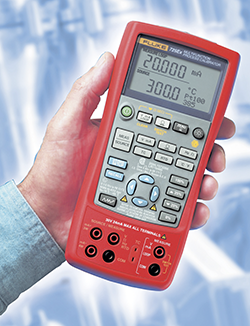

Tracking down problems within a process loop can be a difficult challenge in the best of environments. Doing so in an area that has the potential for explosion takes the degree of difficulty to another level – one where the technician needs proper training and equipment. This article demonstrates the practical application of loop calibrators designed to troubleshoot process loops in Ex environments.
Intrinsic safety (IS) is a protection standard employed in potentially explosive atmospheres. Devices certified as intrinsically safe are designed to be unable to release sufficient energy, by either thermal or electrical means, to cause ignition of flammable material (gas, dust/particulates).
Intrinsic safety is particularly important for technicians working in industries like petrochemical and pharmaceutical, around bulk materials such as grain, in mining, or any environment where explosive gases are present. The importance of safety in these environments cannot be stressed enough, as it takes only a very small amount of energy to cause an explosion. The proper practices and tools will minimise the inherent risk involved in working around these hazards.
Intrinsically safe loop calibration
To conduct loop calibrations in potentially explosive environments, you need a loop calibrator that is certified as intrinsically safe. Intrinsically safe loop calibrators, such as the Fluke 725 Ex series process multifunction calibrator, are certified in accordance with the European ATEX directive (Ex II 2 G Ex ia IIC T4) in Zones 1 and 2 for use in Europe and NEC 500; N.I. Class 1, Division 2 areas Group A-D for use in the U.S.
In addition to an IS loop calibrator, strict adherence to calibration procedures is recommended, including:
Lock out: make sure the system is shut down and other workers are notified that a potentially dangerous operation will be taking place.
Tape off area: tape the work area off to prevent workers from entering with potentially dangerous electrical devices.
Purge or vent the systems: safely purge or vent the system to remove any gases that may remain.
Use a gas detector: in an environment where explosive gas may be present, the use of a gas detector is a prudent step before starting a loop calibration.
Calibrate: perform your calibration using an IS loop calibrator.
Reactivate: at the conclusion of calibration, reverse the process and reactivate the system.
Loop calibration
The 725 Ex can replace the power source in a current loop so you can power and read a transmitter at the same time without carrying a DMM. With the calibrator in control of the current, you can accurately set the current between 4 and 20 mA, controlling the loop and the device connected to it. This makes it possible to test valve positioners (see below), mechanical position indicators, flow indicators and mA signal conditioners.
For testing devices requiring a voltage input, like a signal conditioner or PLC, you can use the source mode of a calibrator in conjunction with a precision resistor to generate accurate voltages. With a DMM or process meter like the Fluke 789, you can measure the output of the signal conditioner and ensure the proper levels are coming out for a corresponding input voltage.
Testing valve positioners
Electronic valve positioners should receive periodic in-field calibrations as part of preventative maintenance programs. Fluke loop calibrators are the ideal process tool for these checks. Valve positioners vary in design and valve type and should be calibrated using specific instructions from the manufacturer.
Quick operational checks can be performed using a field calibrator as a signal source while observing the valve stem position, mechanical position indicators, or flow indicators as input changes are made. Fluke loop calibrators provide a convenient source for simulating the controller output to a valve positioner.
Summary
Calibrating process loops is an essential part of regular plant maintenance, which is made more difficult in potentially explosive environments. Using intrinsically safe tools and the proper procedures to safeguard the working area minimises the risks involved https://bit.ly/3fbfSgB.
| Tel: | +27 10 595 1824 |
| Email: | [email protected] |
| www: | www.comtest.co.za |
| Articles: | More information and articles about Comtest |
© Technews Publishing (Pty) Ltd | All Rights Reserved